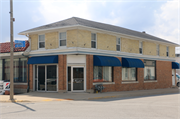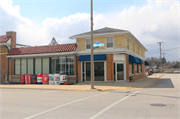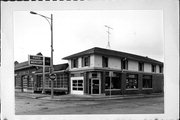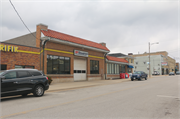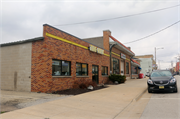Property Record
200 S 2ND ST
Architecture and History Inventory
| Historic Name: | Milwaukee Electric Railway & Light Co. Interurban Dep |
|---|---|
| Other Name: | Grinwald Ford Mercury |
| Contributing: | Yes |
| Reference Number: | 74668 |
| Location (Address): | 200 S 2ND ST |
|---|---|
| County: | Jefferson |
| City: | Watertown |
| Township/Village: | |
| Unincorporated Community: | |
| Town: | |
| Range: | |
| Direction: | |
| Section: | |
| Quarter Section: | |
| Quarter/Quarter Section: |
| Year Built: | 1927 |
|---|---|
| Additions: | |
| Survey Date: | 19862020 |
| Historic Use: | depot |
| Architectural Style: | Spanish/Mediterranean Styles |
| Structural System: | |
| Wall Material: | Brick |
| Architect: | |
| Other Buildings On Site: | |
| Demolished?: | No |
| Demolished Date: |
| National/State Register Listing Name: | Main Street Commercial Historic District |
|---|---|
| National Register Listing Date: | 6/2/1989 |
| National Register Multiple Property Name: |
| Additional Information: | The old Interurban Depot was built for the Milwaukee to Watertown Interurban electric car service which operated between 1908 and 1940. Milwaukee's powerful streetcar company, the Milwaukee Electric Railway and Light Company (TMERL) sought to extend electric car service beyond the city and at the turn of the century it established a subsidiary company, the Milwaukee Electric LIght, Heat and Traction Company that began building electric car lines between Milwaukee and other cities in southeastern Wisconsin. Watertown was the northwestern end point of TMERL's service from Milwaukee. Interurban serice came to the city in 1908. Its tracks came into Watertown at the southeastern edge of town and onto Richards Avenue, then to Western Avenue, and eventually made a loop around the downtown before returning to Milwaukee. The early terminal locations for the interurban are not known. One city directory losted a waiting area at 205 E. Main St. In c. 1927 at large car barn and a Mediterranean Revival style terminal building were built here. Unfortunately, the interurban only remained in service until 1940 and TMERL had been phasing out service in southeastern Wisconsin throughout the 1930s. During World War II the tracks were removed for scrap metal and only this terminal remains from the Interurban era. The old Interurban Depot is significant for loca history under Criterion A because it was the car ban and waiting area at the terminal point for this important mass trabsportation system. Aside from railroad service, the interurban lines were the first atempt at a fast and efficient mass transportation service between major cities in Wisconsin. Interurban lines were established in several areas in the state but the most extensive system was the one TMERL established in southeastern Wisconsin. Interurban cars were fast, clean, and efficient and the arrival of the interurban service from Milwaukee into Watertown was met with a fanfare reserved only for important occasions in the city's history. The automobile and its offshoot, the bus, eventually helped the demise of the interurban system. Cars and buses were more flexible and the good roads movement of the early twentieth century in the state had begun to provide Wisconsin with adequate roadways throughout much of the state. The interurban, hooked to its electric lifeline, could not offer the same services as bus lines. Like resources surrounding the plank roads, interurban resources have been disappearing. Many interurban stations were only overhangs along the tracks and power stations have been converted for other uses. Because of this, any historic interurban resource is particularly significant. Watertown is fortunate to have had a large depot constructed during the 1920's for its interurban line. Its reuse, ironically, as an automobile dealership, has meant its preservation, relatively intact, to today. Because of the rarity and importance of interurban resources, the old interurban Depot meets the criteria for local significance in transportation history. Characterized by bracketed red tile pent roofs, the Mediterranean influenced interurban train shed and depot building is a U-shaped complex. Large multipaned windows and service doors are featured on the facade of the shed while plain large rectangular windows on the two-story depot that forms the north wing of the building have frosted glass transom windows. A flat hipped roof with broad overhanging eaves, exterior shutters on windows with multipaned lights over clear plate glass, and a corner entrance further characterizes the north wing. Large areas of multipaned glass windows are displayed at the rear of the building; on the side elevations copper drain pipes are locared on the facade. The historic Interurban Depot has been altered by the addition of a vehicular entrance on the facade in the placed of a window and the corner entrance has been remodelled. Built in 1927 for the Milwaukee Electric Railway and Light Company, this building has been reused as an auto show room and garage. The Milwaukee Electric Railway and Light Company Interurban Depot is significant under Criterion C as an example of 1920s public transportation architecture influenced by the popular style of the period, the Mediterranean Revival. In addition, the Interurban Station is one of the very few examples of the Mediterranean Revival identified in the 1986 survey of Watertown. Utilizing principally the broad red tile roof typical of the style in its design, the Mediterranean-Mission style Revival style is merely suggested in this example of a public utilities building. Built in the late 1920s, the complex served as a car barn, terminal building and depot until the service to Milwaukee was terminated in 1940. |
|---|---|
| Bibliographic References: | (A) Tax Records, City of Watertown, 1860-1910, Area Research Center, Library, University of Wisconsin-Whitewater. (B) Sanborn-Perris Insurance Map, City of Watertown, 1915, 1926. (C) Barbara Wyatt, Ed., Cultural Resource Management in Wisconsin, Vol. 3, Madison; State Historical Society of Wisconsin, 1986, pp. Transportation 10-1--10-4. (D) "City of Watertown Once had Electric Railway," Watertown Daily Times, June 12, 1976, Section 6, pp. 21-22. |
| Wisconsin Architecture and History Inventory, State Historic Preservation Office, Wisconsin Historical Society, Madison, Wisconsin |

